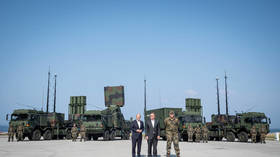Run silent, run scared? US Navy alarmed by ‘effective, advanced’ Russian subs

New, silent, and deadly Russian submarines are challenging NATO’s maritime dominance, says a senior US admiral who calls the current situation a “Battle of the Atlantic,” comparing it to the Cold War and the two World Wars.
“Once again, an effective, skilled, and technologically advanced Russian submarine force is challenging us,” Vice Admiral James Foggo III, commander of the US 6th Fleet, wrote in the June issue of the US Naval Institute’s magazine, Proceedings. “Russian submarines are prowling the Atlantic, testing our defenses, confronting our command of the seas, and preparing the complex underwater battlespace to give them an edge in any future conflict.”
In the article, which was co-authored with naval analyst Alarik Fritz, Foggo argued that a “Fourth Battle of the Atlantic” is underway, comparing the present-day situation to Cold War tensions between NATO and the Soviet Union, as well as the Anglo-American battles with German submarines during the two World Wars.
Russia is “rapidly closing the technological gap” and the “clear advantage that we enjoyed in antisubmarine warfare during the Cold War is waning,” wrote Foggo and Fritz, pointing to the Severodvinsk, a Russian Yasen-class attack submarine commissioned in December 2013, which so impressed the US admiral in charge of submarine construction that he commissioned a model for his office in 2014.
Fourth Battle of the #Atlantic: @USNavy 6th Fleet Commander Warns of #Russian Subs https://t.co/5S25kgisKupic.twitter.com/r6K6iHIBdF
— estNATO (@estNATO) June 3, 2016
Russia is rapidly building and deploying “more advanced and significantly quieter attack submarines and frigates armed with the long-range Kalibr cruise missile,” noted Foggo and Fritz. “Russia has the capability to hold nearly all NATO maritime forces at risk. No longer is the maritime space uncontested. For the first time in almost 30 years, Russia is a significant and aggressive maritime power.”
As proof of Russia’s “aggressive” intentions, Foggo and Fritz quote remarks made in March of 2015 by Russian naval commander Admiral Viktor Chirkov, who said that Russia had increased its submarine patrols by almost 50 percent since 2013, explaining the ramp up was “logical and necessary to guarantee the security of the state.”
The authors also pointed to Russia’s new national security strategy, which describes NATO and the US as threats.
Russia has “blunted our power-projection capabilities through A2/AD and extended its influence far beyond its borders,” they write, using the acronym for “anti-access/area-denial.”
Meanwhile, Foggo and Fritz themselves point out that the US Navy’s strategy for the 21s century “notes the critical importance of all-domain access,” while the Chief of Naval Operations published the “Design for Maintaining Maritime Superiority” in January.
Foggo’s superior officer, Admiral Mark Ferguson, who is the commander of US Naval Forces in Europe and Africa, issued a similar warning about Russian submarines in April.
“The submarines that we’re seeing are much more stealthy,” Ferguson told CNN. “We’re seeing [the Russians] have more advanced weapons systems, missile systems that can attack land at long ranges, and we also see their operating proficiency is getting better as they range farther from home waters.”
While Russian deployments of attack and ballistic missile submarines are at levels unseen since the Cold War, the US Navy has only 53 submarines in service, and that number will drop to 41 by the late 2020s due to budget constraints, Ferguson said.
For all their advanced capabilities, Russia currently has only one operational Yasen-class attack sub, and three Borey-class nuclear missile submarines, compared to the US Navy’s 12 Virginia-class attack boats and three Seawolf-class subs.
Money worries may be behind the US Navy’s sudden obsession with Russian naval power. At $3 billion apiece, the Seawolf was the most expensive US submarine ever built before the program was canceled in 2005. The proposed Pentagon budget for 2017 allocates $18.3 billion for shipbuilding.
“Today, we are once again in a technological arms race with Russia. We must maintain an innovative edge and rapidly field new technologies if we are to prevail,” Foggo and Fritz argue in Proceedings. “We should increase our [anti-submarine warfare] exercises with our NATO allies, in both the Atlantic, Mediterranean, and elsewhere, to demonstrate that NATO can track Russian submarines at will, no matter where they are.”
NATO needs Russia as major foe to maintain bloc’s relevance - Russia’s envoyhttps://t.co/ecyJ7bxBWVpic.twitter.com/H8FmBtAKsI
— RT (@RT_com) June 1, 2016
NATO’s obsession with the “Russian threat” serves to justify the alliance’s continued existence long after the Cold War has ended, Russia’s envoy to NATO, Aleksandr Grushko, told the Rossiyskaya Gazeta daily on Monday. Another objective is to compel European countries to spend more money on American weapons, he added.
The construction of the first Yasen-class sub began in 1993, but it took until 2011 for Severodvinsk to be launched in 2011. Her sisters, the Kazan and the Novosibirsk, are currently being built at the Sevmash shipyards in Severodvinsk. Sevmash has also built three Borei-class nuclear missile submarines and is working on four more.















